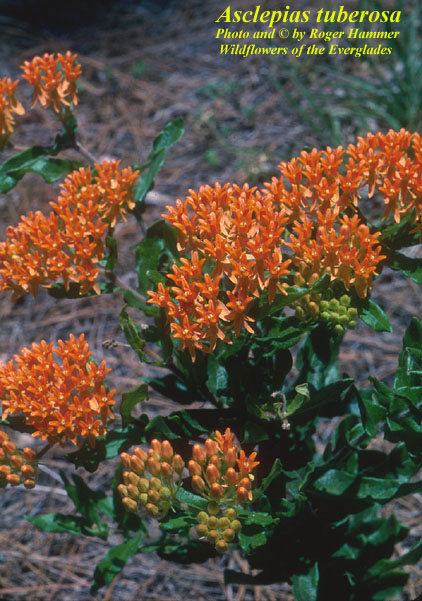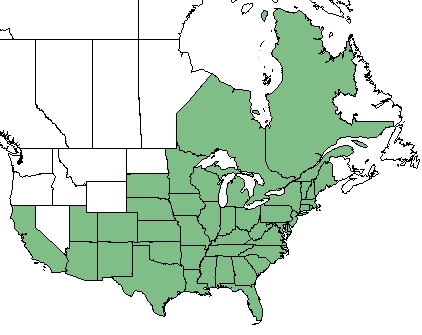Difference between revisions of "Asclepias tuberosa"
(→Cultivation and restoration) |
|||
| Line 49: | Line 49: | ||
==Cultivation and restoration== | ==Cultivation and restoration== | ||
| + | ''A. tuberosa'' can be propagated via seeds or root cuttings. Root propagation can be performed in the fall by cutting the taproot into 2 in (5.1 cm) sections and planting each section vertically while keeping the soil moist.<ref name="Ladybird"/> | ||
| + | |||
==Photo Gallery== | ==Photo Gallery== | ||
<gallery widths=180px> | <gallery widths=180px> | ||
</gallery> | </gallery> | ||
==References and notes== | ==References and notes== | ||
Revision as of 15:34, 13 February 2018
| Asclepias tuberosa | |
|---|---|

| |
| Photo by the Atlas of Florida Plants Database | |
| Scientific classification | |
| Kingdom: | Plantae |
| Division: | Magnoliophyta - Flowering plants |
| Class: | Magnoliopsida - Dicots |
| Order: | Gentianales |
| Family: | Asclepiadacea |
| Genus: | Asclepias |
| Species: | A. tuberosa |
| Binomial name | |
| Asclepias tuberosa (L) Brittonex Vail | |

| |
| Natural range of Asclepias tuberosa from USDA NRCS Plants Database. | |
Common Names: midwestern butterfly-weed; sandhills butterfly-weed; common butterfly-weed;[1] butterfly milkweed; Rolfs' milkweed;[2] orange milkweed; pleurisy root; chigger flower[3]
Contents
Taxonomic Notes
Varieties: A. tuberosa var. interior; A. tuberosa var. rolfsii; A. tuberosa var. tuberosa.[1] Other sources list these three varieties as subspecies.[2]
Synonyms: A. rolfsii; A. decumbens[1]
Description
Asclepias tuberosa is a dioecious perennial forb/herb.[2] It is bushy and grows to 30-60 cm in height. Leaves are alternate, pointed, smooth on the edge, and 1.50-2.25 in (3.81-5.72 cm) long. Flat-topped clusters 2-5 in (5.1-12.7 cm) diameter contain flowers,[3] which range from a yellow to yellowish orange or a deep-orange to reddish.[1][3] Despite its common name, milkweed, it has no milky sap.[3]
Distribution
This species is found from Quebec and Maine, westward to Ontario and Minnesota, southwestward to South Dakota, Colorado, Utah, Arizona, and California, and southward to central Texas, the Gulf Coast, and peninsular Florida.[2]
Ecology
Habitat
A. tuberosa occurs in dry forests, roadbanks, sandhills, woodland margins, roadsides, and pastures.[1]
Phenology
In the southeastern and mid-Atlantic United States, A. tuberosa flowers from May through September and fruits from August through September.[1]
Pollination
This species is of special value to bumble bees, honey bees, and native bees and can attract butterflies and hummingbirds as well.[3]
Use by animals
This species composes 2-5% of the diet of some large mammals and terrestrial birds.[4] Humans will often utilize this plant in home gardens because of its color and ability to attract butterflies. Native Americans also used to chew the root as a cure for pleurisy or other pulmonary ailments.[3]
Conservation and Management
Cultivation and restoration
A. tuberosa can be propagated via seeds or root cuttings. Root propagation can be performed in the fall by cutting the taproot into 2 in (5.1 cm) sections and planting each section vertically while keeping the soil moist.[3]
Photo Gallery
References and notes
- ↑ 1.0 1.1 1.2 1.3 1.4 1.5 Weakley AS (2015) Flora of the Southern and Mid-Atlantic States. Chapel Hill, NC: University of North Carolina Herbarium.
- ↑ 2.0 2.1 2.2 2.3 USDA NRCS (2016) The PLANTS Database (http://plants.usda.gov, 13 February 2018). National Plant Data Team, Greensboro, NC 27401-4901 USA.
- ↑ 3.0 3.1 3.2 3.3 3.4 3.5 3.6 Plant database: Asclepias tuberosa. (13 February 2018) Lady Bird Johnson Wildflower Center. URL: https://www.wildflower.org/plants/result.php?id_plant=ASTU
- ↑ Miller JH, Miller KV (1999) Forest plants of the southeast and their wildlife uses. Southern Weed Science Society.